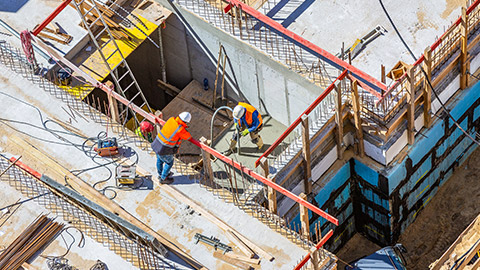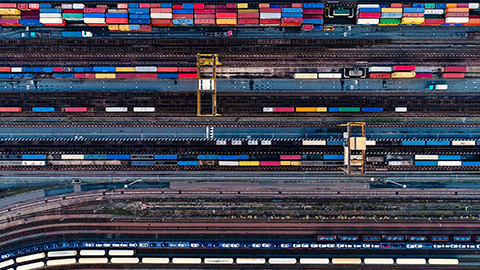Welcome to Valuing the Role of Construction!
This is the first topic of our Compliance Knowledge module.
Our aim in this topic is to:
- Identify the importance of construction in New Zealand.
- Understand the construction industry in New Zealand.
Module 5 Introduction from Will
Click 'Video Transcript' or the plus icon (+) to expand and reveal the transcript for the previous video.
G’day. Welcome to the learning bite modules. For each module, you’ll have a range of understandings to cover, from different types of building governing legislations and the terminologies involved - to learning about the government environmental frameworks and New Zealand consumer protection warranties. There’s a lot to cover, so we’ve split it all up so you can take one bit at a time. Rome wasn’t built in a day, and you’re not expected to memorise this overnight! I’m going to take you through the introduction each step of the way and get you a feel for what it is you're looking at before you jump into it. See ya there!

There are many different ways in which the construction industry contributes to our society. The five key highlights of the construction industry's contributions in New Zealand include:
- Economic growth: The construction sector is a significant contributor to the country's economy, generating employment and investment and driving economic growth through infrastructure development, residential and commercial building projects, and associated industries.
- Infrastructure development: Construction contributes to the development of essential infrastructure, including roads, bridges, utilities, and transportation networks, improving connectivity and enabling the movement of goods and people.
- Housing: The construction industry plays a pivotal role in providing new housing, supporting residential needs, addressing housing shortages, and contributing to community development.
- Innovation and technology: The sector fosters innovation, adopting new technologies and building methods that enhance efficiency, sustainability, and safety in construction projects.
- Community development: Construction activities contribute to the overall development of communities by improving the urban landscape, providing amenities, and supporting the growth of businesses, industries, and public services.
Economic growth highlights
The construction sector delivers almost as much of New Zealand's national bank balance as the whole Waikato region, and this contribution is growing.
The construction sector plays a large role in New Zealand's economy; it contributes strongly to employment, businesses, and New Zealand's national bank balance (GDP).
Construction is the fifth-largest sector by employment, comprising around 295,300 in the workforce. This accounts for 10.5% of total employment across the whole economy sector as of 2015. The Construction sector delivers almost as much of New Zealand's GDP as the whole Waikato region; this is about 6.7% of New Zealand's total GDP. Over the last three years, core construction has seen a big growth, overtaking the wholesale trade as one of the biggest contributing financial sectors.
Improving the sector's performance provides a range of extra benefits that will be shared across the industry and to the customers.
- For the industry, this means even better profit margins, better skills upskilling, and greater cross-functional learning opportunities for its workers.
- For the clients, this means a higher quality of construction for less cost and improved project timeframes with fewer delays.
So, in the long term, general construction productivity would benefit New Zealand more.
Infrastructure contributions

Construction infrastructure is vital for society as it provides the necessary physical systems, like roads, bridges, and utilities, supporting economic growth, connectivity, and improved living standards. It enables movement, trade, and access to essential services, contributing to community development and a better quality of life. Here are some examples:
- Transport networks: such as road, rail, airports, and motorways.
- Drainage: the provision of waste connections to houses, offices and other commercial buildings like shops.
- Provision of services: the supply of water, gas, electricity and communications to our houses and towns.
- Flood defences: defences to protect our buildings from flooding by rivers and rising sea levels.
Types of construction projects
Construction also covers many types of work, from taking on projects for private individuals to commercial property development. Here are some examples:
- Industrial: factories, workshops, industrial estates or units.
- Residential: private houses, apartments, or social housing.
- Commercial: retail units, shops, offices, and business parks.
- Health hubs: hospitals, community care centres, retirement homes, clinics, and medical centres.
- Education facilities: schools, universities, or training centres.
- Leisure and recreation facilities: cinemas, sports facilities, all-weather facilities, and football stadiums.
This is important later in your studies, especially around recognising building classification types and their legislative requirements.

The commercial construction industry is rapidly expanding not only in New Zealand but across the world. With the advent of new construction materials, technology, and design approaches coupled with the impact of climate change, the building landscape and regulatory environment are undergoing a significant transformation. To meet the demands of these changes, the industry requires more skilled workers who can work with all of these innovations, and procedures especially those related to the commercial field.
Taken from Stats NZ, non-residential buildings contribute 20% of New Zealand's carbon emissions. With the introduction of the Zero Carbon Act, new building systems and practices will become more environmentally friendly.
New Zealand especially has experienced a boom in commercial building projects, particularly in major cities like Auckland, Wellington, and Christchurch. A combination of factors such as population growth, increased tourism, and individual business expansion has driven this.
The National Construction Pipeline Report of 2023 created by BRANZ provides an insight into the view of upcoming building and construction activity over the next 6 years.
Review the infographics and summary findings on the National Construction Pipeline Report 2023.
This report has forecasted that the value of the infrastructure-building activity is to increase to a new high in 2026 and remain steady at this new level, largely driven by the extreme weather rebuild and increasing resilience throughout the country.
The report has also forecasted the value of non-residential building activity to reach a modest high in 2024 and to remain steady and consistent throughout the remainder of the 6-year forecasted period. Commercial, education and health-building activities make up 3 quarters of non-residential projects expected to start in the next year.
With all these new ventures in the pipeline, the Chief executive of Naylor Love, Bruno Goedeke outlines the rise of commercial construction here in New Zealand. The video can be viewed here.
As a construction site supervisor, you are playing an important and exciting part in improving the state of Commercial construction in New Zealand.
